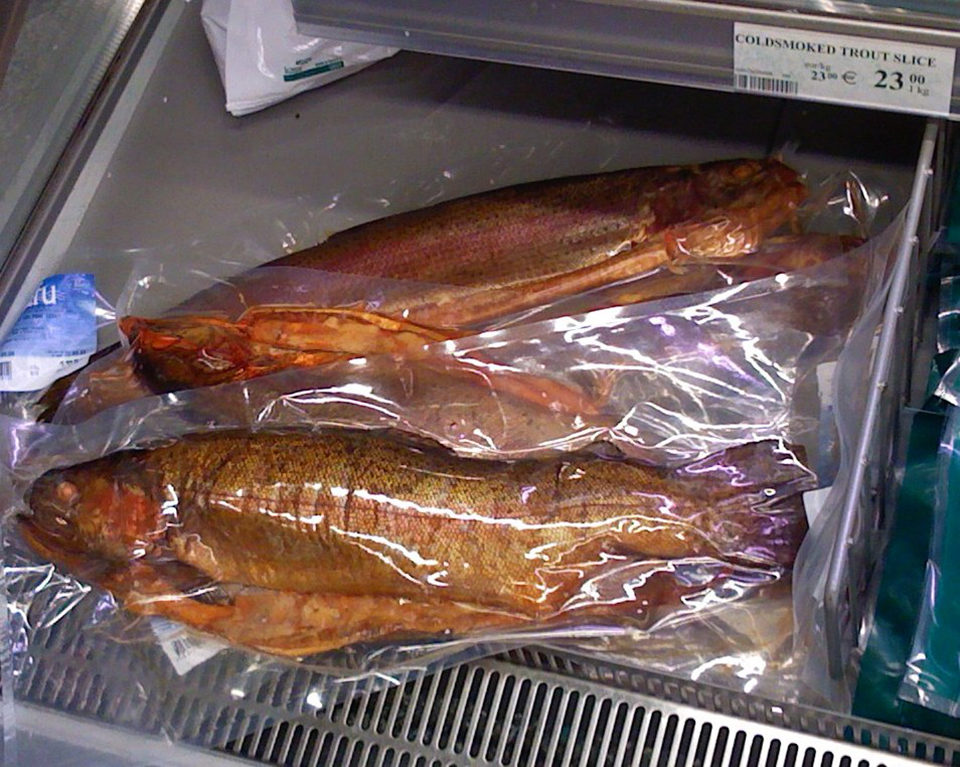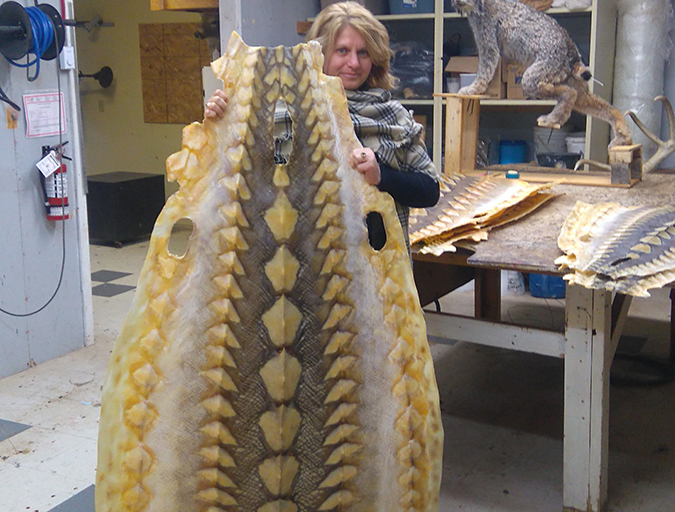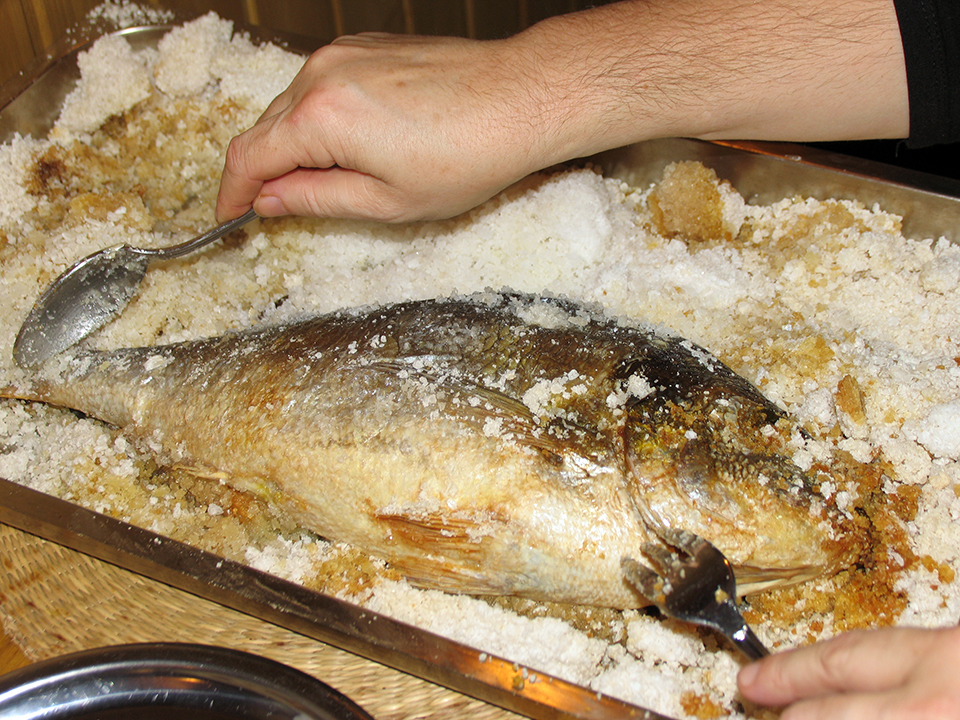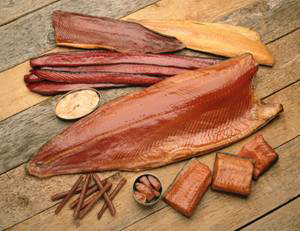Old product with new appeal offers enhanced taste, shelf life

Smoked fish, arguably one of the oldest of all processed fish products, continues to increase in popularity. Traditional smoked favorites include chub, whitefish, haddock, cod and kippers, but new species, including many from aquaculture, are now available in the marketplace.
Some of the new finfish species include eel, salmon, trout, dogfish, sturgeon, mackerel and shark. Recently, oysters, clams, mussels and scallops have also become available in smoked form.
New value-added products featuring smoked fish or shellfish have been enthusiastically received by consumers. The list includes pâtés, dips, spreads, salads and snacks. Smoked fish have also been marketed with pepper coatings, herbed seasonings (especially dill) and honey glazing, and infused with various other flavorings.
Aquaculture has had a significant impact on the availability of smoked products. In prior years, smoked products were considered a luxury or specialty ethnic food due to their high cost. However, aquaculture has enabled many fish species to be produced affordably, which makes more product available for “specialty” processing and keeps consumer costs low. Recent fishery statistics show that some of the newer value-added products on the market are gaining rapidly on some of the more traditional fresh and frozen market forms.
Fish preservation
The smoking process provides fish and other smoked products some protection against spoilage when compared to fresh products. Modern smoked products need to be stored at temperatures between 0 and 3 degrees C to reduce spoilage and prevent the growth of toxin-producing microorganisms. When smoked products are properly stored, they should have shelf lives that range from one to four weeks. Products that have been heavily smoked may not require refrigeration.
The preservation of fish and shellfish through smoking is achieved through several steps that are considered as a single unit process:
- Surface drying provides a physical barrier to the penetration of bacteria and does not create an acceptable growth environment.
- Salting reduces water activity, which inhibits the growth of many pathogenic microorganisms. However, for salting to be completely effective, it may be necessary to apply approximately 5 percent salt, which makes most products too salty for consumers.
- Deposition of phenolic antioxidant compounds, which delay lipid oxidation.
- Deposition of antimicrobial substances, such as phenols, nitrites and formaldehyde.
Lactic acid bacteria
Recent research has shown that the incorporation of lactic acid bacteria (LAB) can serve as a biopreservation method. These bacteria are generally recognized as safe, and do not present a human health hazard. The food-grade products produce some antimicrobial metabolites and are readily accepted by consumers due to their probiotic associations. As subjects of significant research over the years, their physical and biochemical effects on foods are well understood.
LAB produce bacteriocins, proteins or peptides that inhibit the growth of spoilage and pathogenic microorganisms. In general, lactic acid bacteria do not affect the taste or aroma of foods and do not contribute to spoilage. The bacteriocins are not considered a health risk, since they are destroyed by enzymes in the stomach.
The greatest use of LAB has been in the inhibition of the human pathogens Listeria monocytogenes, Staphylococcus aureus and Clostridium botulinum. Strict control of L. monocytogenes is necessary, since many countries have established a zero-defect action level in ready-to-eat products.
Carnobacterium piscicola has emerged as the major microorganism to control L. monocytogenes, since it is routinely isolated from many seafood products, including smoked fish. However, not all C. piscicola produce bacteriocins; only certain cultivars exhibit this trait.
The inhibitory spectrum of bacteriocins is generally restricted to Gram-negative bacteria. Other bacteria, such as Lactobacillus, Leuconostoc, Pediococcus and Enterococcus faecium, also produce bacteriocins. Bacteriocins do not work efficiently when used as “stand-alone” preservatives in refrigerated foods. However, they can work synergistically when used in a multiple-barrier preservation system.
Additional research may be required before bacteriocin-producing bacteria can be widely used as a form of biological control. Today, nisin, a compound produced by LAB, is the only bacteriocin approved as a food preservative in more than 50 countries.
Smoke production
Smoke can be produced with logs, wood chips or sawdust. Logs produce a hotter fire with less smoke unless the process is carefully controlled. Sawdust smolders easily and produces more smoke that can be applied to the product. The lower temperatures required when using sawdust provide a smoke that has greater preservative and flavor compounds. Smoking at higher temperatures oxidizes these preservative and flavoring compounds to form carbon dioxide and water.
It is important to carefully select wood since prior exposure to pesticides or industrial chemicals could result in the presence of human toxicants. Hardwood is preferred because it imparts a milder flavor, while softwoods such as pine and fir impart a more resinous flavor. The preferred smoking woods are maple, oak, hickory, mesquite, cherry, apple and beech. While some firms claim one type of wood as superior to another with respect to taste, only the most discriminating consumer can truly detect the difference.
Smoking process
Since most of the smoke components found in smoked fish are absorbed by the surface and interstitial water of the fish muscle, it is important that the fish remains moist, at least for part of the smoking process. It has been reported that the rate of absorption of phenolic compounds in predried fish is only 5 percent of that absorbed by wet fish. The objectives of a modern smoking process should be to uniformly impart the desired sensory characteristics to the product, extend product shelf life and avoid the deposition of known carcinogens.
The characteristic golden color of smoked seafood products is due to the interaction of carbonyls with amino components on the flesh surface. It has also been found that as fish spoils, amine compounds become increasingly important in determining the extent of browning.
For a standard smoking process, the condition and extent of spoilage of the raw material can affect the extent of color formation. Nitroso substances in smoke produce a pink color in the flesh of smoked fish. It has been suggested that the nitroso substances are also capable of forming carcinogenic N-nitrosamines by reaction with amines in the fish muscle.
Smoked seafood can contain up to 0.5 grams of smoke constituents per 100 grams of tissue. Some of the volatile compounds may be carcinogenic. The most prominent of these is benzopyrene, the concentration of which can decrease during storage. The most benzopyrene is absorbed during the final, hottest stage of smoking. Eight to nine times more benzopyrene is absorbed during hot smoking than during cold smoking.
The flavor and aroma of smoked fish are primarily due to the presence of phenols. Hot and cold smoking processes produce different phenolics in smoked products. The compounds in smoke with lower molecular weight are responsible for the desirable flavor of the smoked product. The higher-molecular-weight compounds are generally regarded as imparting a “burned” or harsh phenolic sensory characteristic.
Studies have concluded that traditional smoked processing methods do not adversely affect the protein quality or fatty acid profile of the flesh. However, if the product is severely overheated, some of the amino acids may be reduced in availability. None of the modern processes utilize processing temperatures that high.
Editor’s Note: This article should have preceded, as part I, George Flick’s article in the March/April Global Aquaculture Advocate: “Smoked Fish – Part II. Proper Salting, Drying Procedures Essential.”
(Editor’s Note: This article was originally published in the May/June 2010 print edition of the Global Aquaculture Advocate.)
Author
-

George J. Flick, Jr., Ph.D.
Food Science
And Technology Department
Virginia Tech/Virginia Sea Grant (0418)
Blacksburg, Virginia 24061 USA[117,100,101,46,116,118,64,103,107,99,105,108,102]
Related Posts

Innovation & Investment
American Unagi brings eel farming back ‘home’
Sara Rademaker launched American Unagi to shift eel farming to American soil, where the eels are from. Why? Because of the novelty, and because she saw an opportunity to do things better.

Intelligence
As sturgeon farming grows, demand concerns emerge
Caviar, or lightly salted sturgeon roe, has been enjoyed for centuries as an expensive gourmet delicacy. After a drastic decline in wild sturgeon stocks, aquaculture stepped in to fill the void. But can farmed supply find lasting balance with market demand?

Intelligence
Smoked fish, part 2
An important step in preparing smoked fish is obtaining uniform distribution of salt in the finished product. Dry salt curing is effective but requires experimentation and experience for best results.

Intelligence
Smoked fish, part 3
Primarily used for salmon, cold smoking does not cook fish but adds flavor and increases shelf life by reducing moisture content. Hot smoking is used for the majority of smoked fish products.

